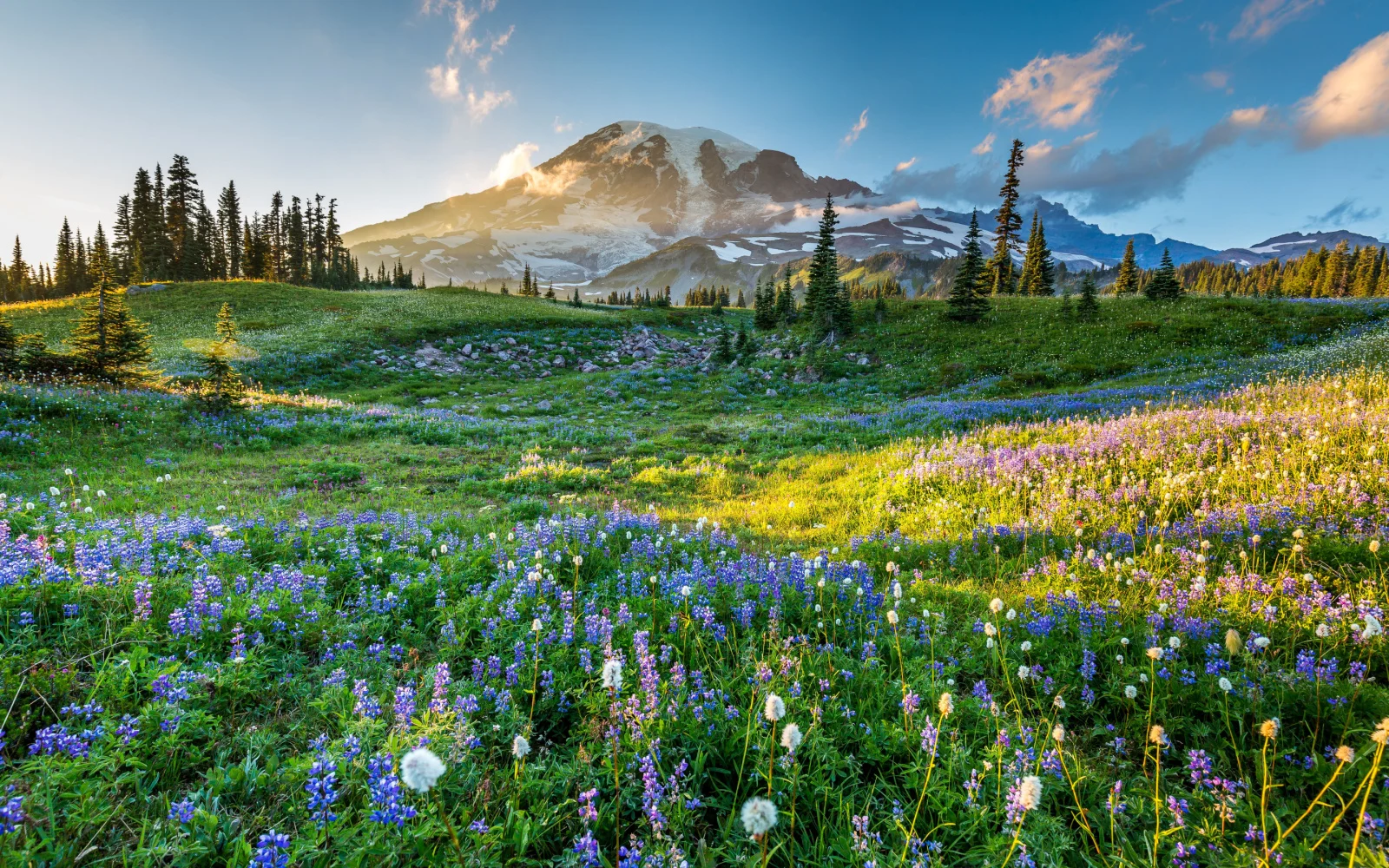What's the best time to visit Mount Rainier?
The best time to visit Mount Rainier is from mid-July to September, when the park is fully accessible and the weather supports outdoor activities. This period offers clear trails, blooming wildflowers in areas like Paradise and Sunrise, and active wildlife. With all facilities open and a range of ranger-led programs available, it’s an ideal time for hiking, viewing wildlife, and learning about the park’s natural environment.
Mount Rainier, an active volcano and the highest point in Washington State, is a great getaway from Seattle and one of Washington’s best natural areas.
Visitors to Mount Rainier can take in beautiful views of the mountain and the rest of the Cascade Mountains. There are plenty of trails for hiking and biking, but also scenic roads so you can explore with your car.
Be sure to stop off at waterfalls such as Myrtle Falls, gaze at the wildflowers in the Paradise area of the park, or check out historic areas within the park including Longmire.
Mount Rainier is an outdoors lover’s dream, especially when the park is at its peak. Keep reading to learn more about the best, least busy, cheapest, and worst times to visit; let us be your guide!
Overall Best Time to Visit Mount Rainier
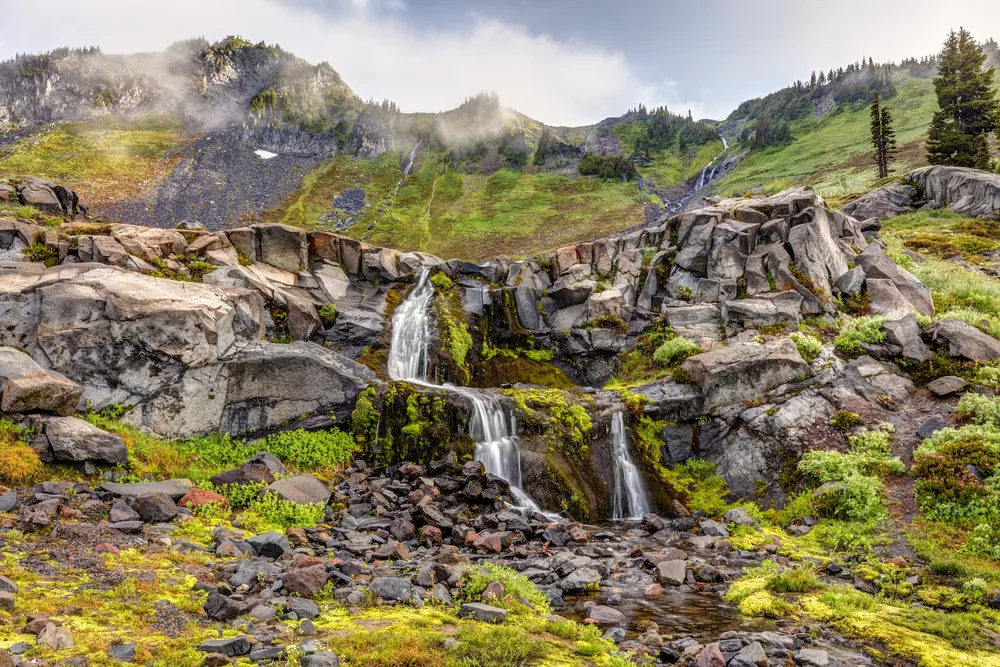
Pierre Leclerc/Shutterstock
The best time to visit Mount Rainier is during late summer, from mid-July to September. This period is the only window of time when the park is fully accessible.
Thanks to Mount Rainier’s high elevation, winter lasts a long time. The peak is at 14,410 feet above sea level, and much of the park is over 3,000 feet above sea level. That means that cold weather and snow stick around late into the year.
Some high-altitude trails aren’t fully clear of snow until early July. Weather conditions in Mount Rainier differ a lot based on elevation, but even high in the mountains, summer is relatively pleasant.
At low-lying levels such as Longmire, summer high temperatures average around 75 degrees Fahrenheit. Higher in the mountains, conditions are cooler.
July average temperatures in Paradise are around 64 degrees Fahrenheit. The landscape is beautiful as it comes alive to enjoy the short summer. The most famous destinations are Paradise and Sunrise, areas of the park that are known for their wildflower meadows.
Due to the high altitude, flowers don’t bloom until July, but you can spot spectacular floral carpets in July and August. Summer is also one of the best times to spot wildlife in Mount Rainier.
Animals such as marmots, grouse, and more are more active in the summer. Plus, locations at higher altitudes such as Sunrise, where you are more likely to spot animals such as mountain goats or ptarmigans, are only accessible in the summer.
Thanks to the warmer weather, all hiking trails and park areas are open for visitors. Amenities such as restaurants, camping grounds, and visitor centers are also fully open in the summer.
There are also more things to do because there are more guided ranger programs and tours.
Most events at the park, such as night sky programs, evening talks, and guided hikes, occur from July to September. These programs are particularly interesting for kids, who can learn more during their visit thanks to this extra context.
Cheapest Time to Visit Mount Rainier
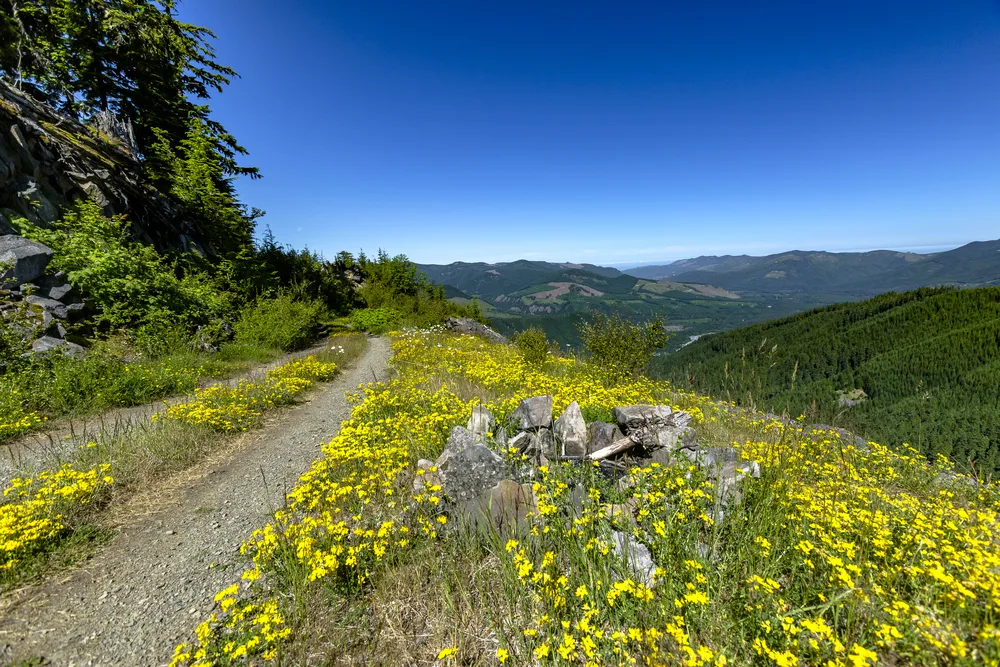
Jason Finn/Shutterstock
The cheapest time to visit Mount Rainier is in the winter. While the cost of visiting the mountain itself doesn’t change that much depending on the season, getting there and staying nearby is more affordable in the off-season.
Outside of the summer, there are few accommodation options in Mount Rainier itself. Only the National Park Inn at Longmire is open throughout the year.
In the winter, you can save money on accommodations in nearby towns. The town of Parkwood is a popular gateway for visiting Mount Rainier, and its hotels tend to have lower rates in the winter, when there are fewer visitors.
Some hotels have discounts of 50% in January, allowing you to save a lot of money. For out-of-state visitors, the best way to get to the mountain is to fly into nearby Seattle and then rent a car.
Flights are at their lowest prices from December to mid-February, when the rainy weather of the Pacific Northwest lowers tourism demand. You can also negotiate discounts from car rental companies since demand is lower than during the peak season.
Least Busy Time to Visit Mount Rainier
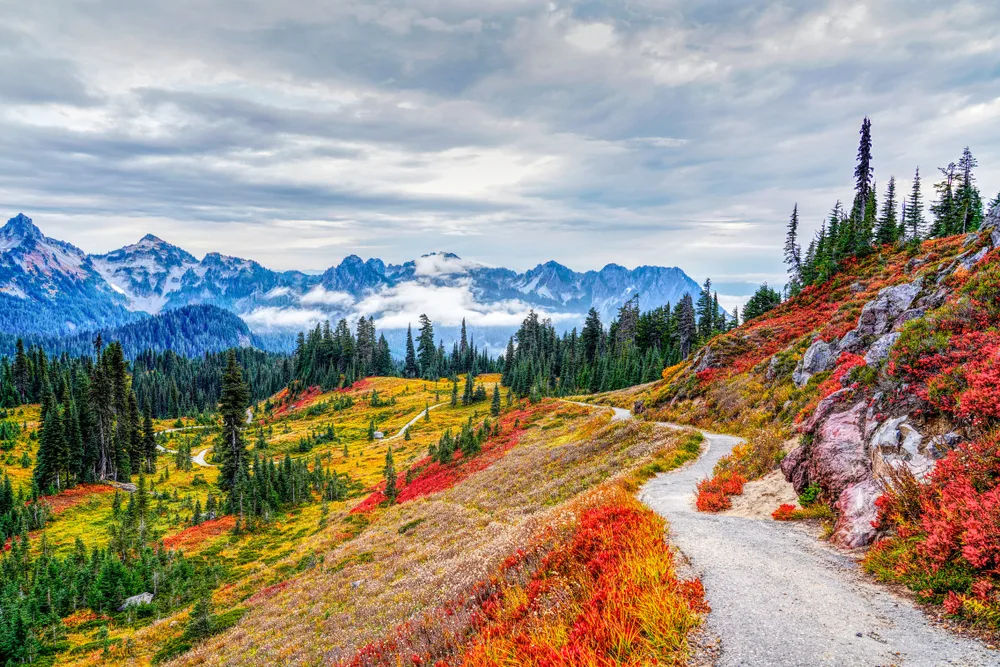
Dmitry Kovba/Shutterstock
The least busy time to visit Mount Rainier is in the spring or the fall, when there are far fewer crowds than in the summer. In recent years, summer in Mount Rainier has become very crowded.
There are so many visitors that the park has implemented a timed entry reservation system for the two most popular areas, Paradise Corridor and Sunrise Corridor.
Between late May and early September, you need to reserve a permit in advance to enter. Outside of those months, you’ll find the park pleasantly free of crowds.
Visiting in the spring (April to mid-May) or fall (mid-September to October) allows you to visit the park before the snow covers most of the trails, and when there aren’t as many crowds. Spring and fall can get chilly, especially at higher elevations.
However, at lower elevations the temperatures are mild, especially during the day. At Longmire in October, you can expect average daily temperatures of about 57 degrees Fahrenheit.
Some of the park’s main attractions remain open in fall. For example, the Longmire Museum is in operation from October to January 1st, it just has shorter operating hours than during the summer. Most visitor centers also stay open until mid-October.
Fall is a great time to visit to check out the changing leaves. At higher altitudes, you can see foliage as early as late August and September, while the peak colors at lower altitudes are in September and October.
There usually isn’t major snow until mid-October, so roads and trails stay open. There are fewer cars around, so you can enjoy your scenic drives—or opt for two wheels instead.
Spring has fewer activities than the fall. The snowpack means a lot of trails are still closed.
It’s also a bit of a dead zone in terms of activities, as winter programming winds down but the park is still getting ready to open for summer. However, there are still trails at lower altitudes open for exploration, and you’ll have a lot of space to yourself.
Worst Time to Visit Mount Rainier
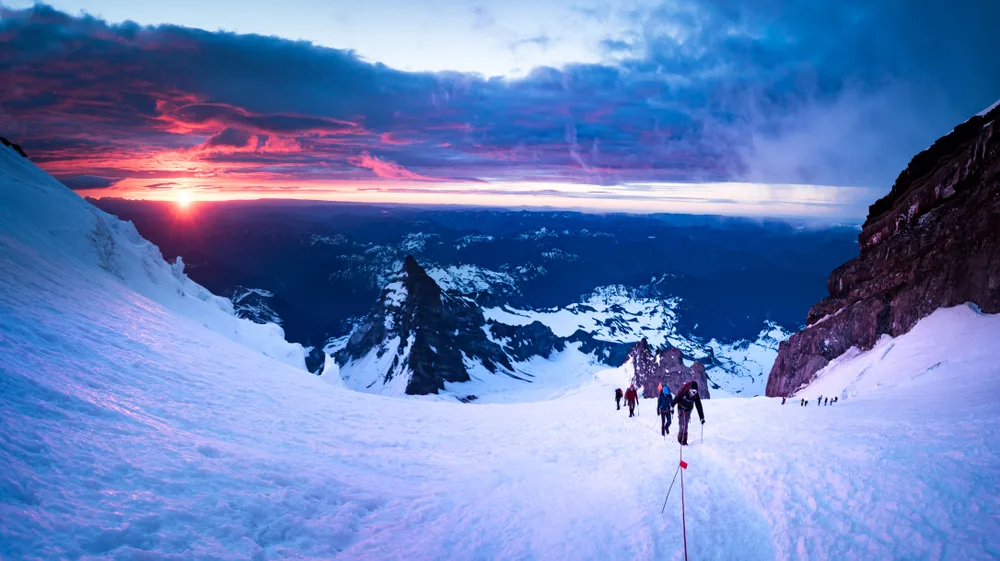
Kevin Kopf/Shutterstock
Unless you are a fan of winter sports, the worst time to visit Mount Rainier is during the long winter months (from November to early April) due to difficult conditions and cold weather.
It can get very cold in Mount Rainier. At Paradise and other popular visitor locations, temperatures are usually around freezing during the day and colder at night. Higher in the mountains, it is much colder.
Of bigger concern than the cold is the snow. Since it is a cold and mountainous area, Mount Rainier gets a lot of snow. Due to snow, there are a lot of road and trail closures, and you may not even be able to get to the areas that you wanted to see.
Make sure that you look up the road status before you visit to see closure updates and safety requirements—cars need to have tire chains during part of the year.
The high level of snowfall means that parts of the park can get unsafe during the winter. The National Park Service warns winter hikers about the risks of sudden storms, avalanches, and snow covering up unstable ground.
Make sure you pack safety gear, including a GPS, heat pack, and small shovel, look up conditions ahead of time, and follow ranger warnings. However, there is some charm to visiting the park in winter.
The landscape looks even more majestic when it’s covered in snow. This is also the only season when you can try winter activities including snowshoeing or skiing down a glacier.
Mount Rainier by Month: Climate & Activities
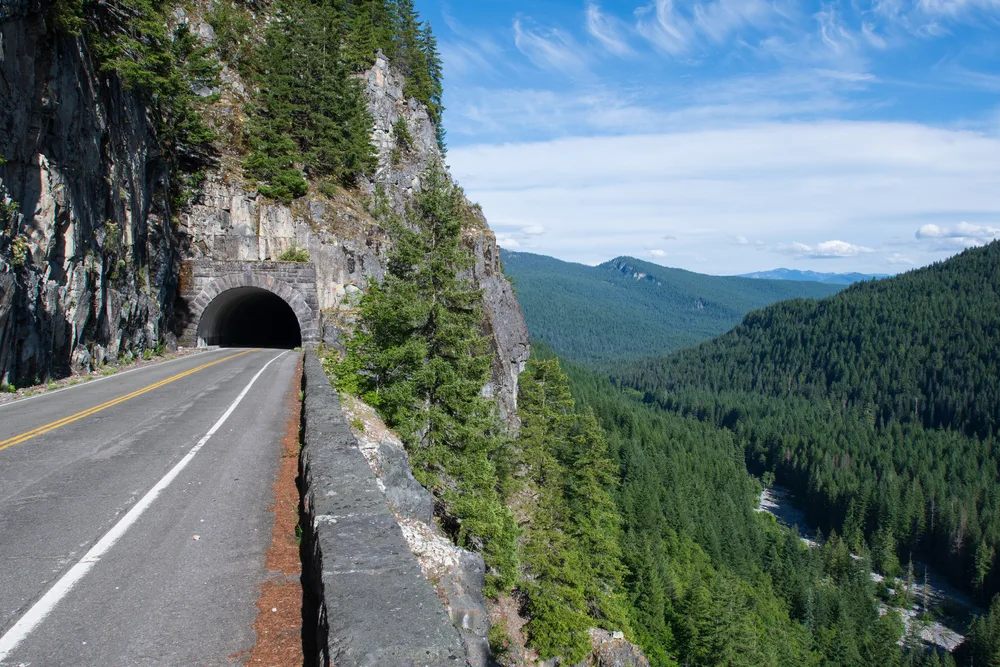
Caleb Jones Photo/Shutterstock
Still unsure about the best time to visit Mount Rainier? Take a look at our summary of the weather and climate by month below:
January
January in Mount Rainier National Park, often with temperatures from 19 to 35°F (-7 to 2°C), is a winter wonderland. It’s perfect for snowshoeing amidst the snowy landscapes, cross-country skiing, and enjoying the serene beauty of the snow-covered mountain.
February
February continues the snowy splendor, ideal for winter photography capturing the majestic Rainier, participating in ranger-led snowshoe walks, and enjoying the quiet trails of the Paradise area.
March
As spring approaches, March offers temperatures ranging from 22 to 39°F (-6 to 4°C). Witness the start of the snowmelt, explore the lower elevation trails like the Nisqually Vista, and visit the Henry M. Jackson Visitor Center for educational exhibits.
April
April’s milder weather, with temperatures between 28 to 47°F (-2 to 8°C), beckons for scenic drives along the park’s open roads, viewing the early spring wildflowers, and enjoying clearer skies for breathtaking views of the mountain.
May
May brings warmer days, from 35 to 57°F (2 to 14°C), perfect for hiking the lower elevation trails, such as those around Longmire and Ohanapecosh, and experiencing the vibrant spring greenery and waterfalls.
June
June, welcoming summer with temperatures between 41 to 66°F (5 to 19°C), offers ideal conditions for visiting the Sunrise area for panoramic views, exploring wildflower meadows, and hiking to pristine alpine lakes.
July
July’s warmth, with temperatures from 47 to 73°F (8 to 23°C), is all about enjoying the peak wildflower season in the Paradise area, taking on challenging hikes like the Skyline Trail, and experiencing the beauty of subalpine meadows.
August
In August, with temperatures of 47 to 72°F (8 to 22°C), hike to the Camp Muir high camp for a taste of mountaineering, enjoy star-gazing parties on clear nights, and explore the Grove of the Patriarchs for a walk among ancient trees.
September
Welcoming fall, September, with temperatures from 40 to 65°F (4 to 18°C), is perfect for viewing the autumn colors, enjoying the quieter trails after the summer crowds, and visiting the historic Paradise Inn.
October
October’s cooler days, from 31 to 54°F (-1 to 12°C), are ideal for scenic drives to view the fall foliage, exploring the Myrtle Falls and Silver Falls, and experiencing the tranquil side of the park before winter sets in.
November
November, as the chill returns, temperatures from 25 to 41°F (-4 to 5°C), is a time for enjoying the early snows on the mountain, visiting the Longmire Museum, and experiencing the quietude of the park’s offseason.
December
December brings back the winter landscape, with temperatures ranging from 19 to 35°F (-7 to 2°C). This month is perfect for winter camping for the adventurous, snowboarding or skiing in designated areas, and enjoying the peaceful winter ambiance of the park.
Frequently Asked Questions
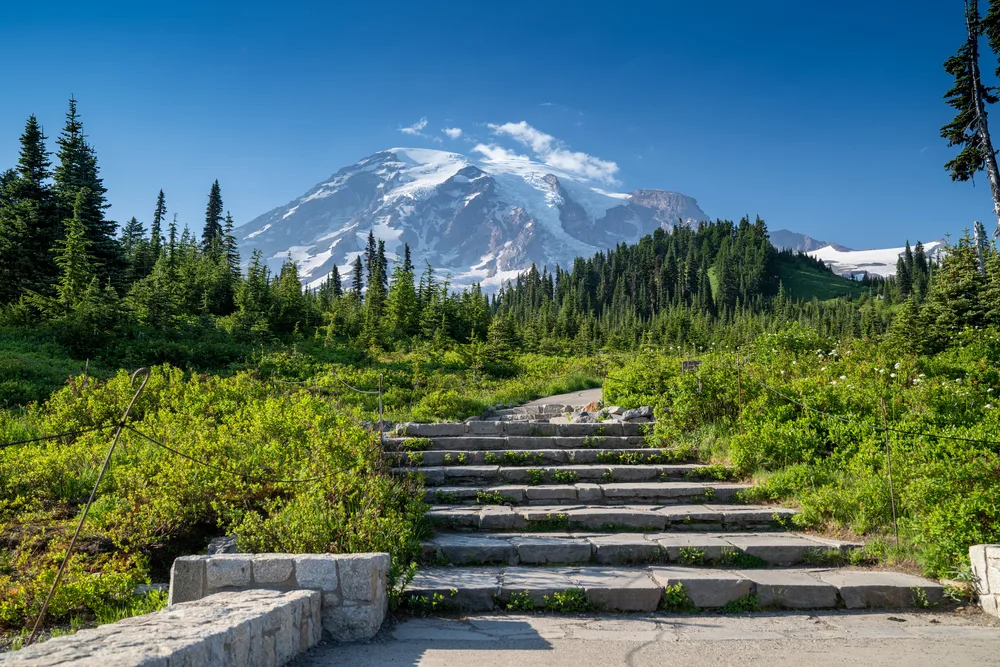
Melissamn/Shutterstock
Here are a few of the most common questions people have asked about visiting Mount Rainier:
What month is best for Mount Rainier?
The best month to visit Mount Rainier is July. The weather is warmest and the snow has melted, so all trails are accessible, and the wildflowers are in bloom.
How many days do you need in Mount Rainier?
If you love the outdoors, spend at least two days in Mount Rainier. If you just want to get a good view of the mountain, you can explore the main areas of the park in just a day.
What months is Mount Rainier open?
Mount Rainier National Park is open all year round. Some amenities within the park, such as some visitor centers, are only open from May to October.
How often is Mt. Rainier visible from Seattle?
Mt. Rainier is visible from Seattle, but only on clear days. In total, this amounts to less than three months a year since Seattle’s weather is famously rainy.
Is Mt. Rainier worth it?
Mt. Rainier is absolutely worth visiting because it is one of the best mountain landscapes in the region. Plus, it’s close enough to Seattle that it’s a manageable day trip.
So, What’s the Best Time to Visit Mount Rainier?
The best time to visit Mount Rainier is in the summer, when the snow melts and the trails are all clear. During the short, glorious summer, enjoy wildflowers, hiking trails, and beautiful natural wonders.
So, with so much to see and to and plenty of amazing times to visit, what are you waiting for — book your trip today and experience for yourself all that Mount Rainier has to offer. Happy travels!



